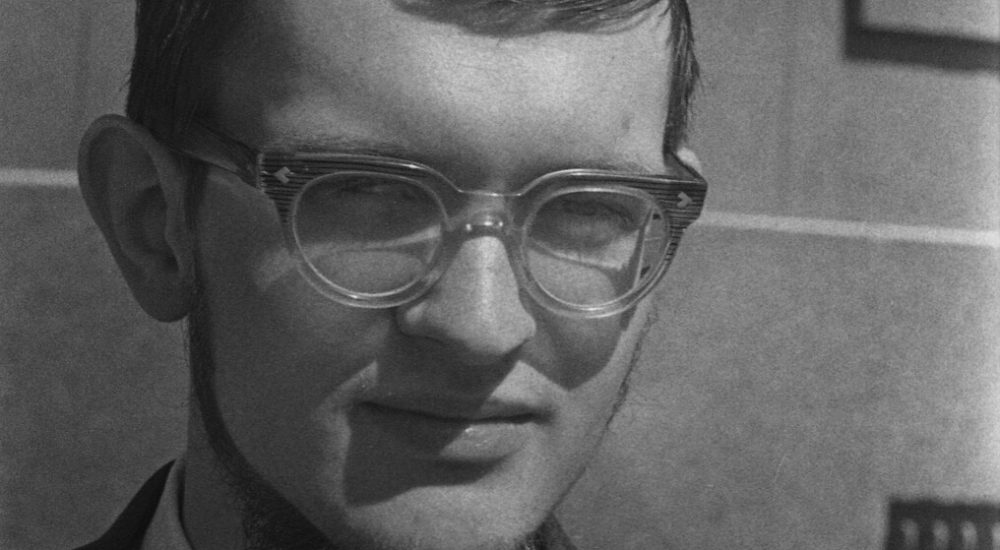
Kuldar Sink was one of the youngest reformers of Estonian music in the 1960s.
He graduated from the Tallinn Music School in music theory in 1960 and flute in 1961, also studying composition under Veljo Tormis. From 1961–1966, he continued his composition studies at the Leningrad Conservatoire under Andrei Petrov. In 1960–1963 Sink worked as a flutist at the “Estonia” Theatre Orchestra, and in 1963–1973 at Estonian TV and Radio Symphony Orchestra. From 1973 to the end of his life, Sink was a freelance composer.
Sink as a composer was in permanent search of new stylistics. Famous as a bold experimenter with avant-garde compositional techniques, he did not strive toward an overwhelming control of the musical process in his works. His music is full of spontaneity and stylistic contrasts. Within stylistic changes, the special character of Sink’s idiom stayed unchangeable – fragile, detailed and colourful texture.
In 1960, Sink’s Three Pieces for string orchestra awakened interest for their soft harmonic texture and unity of interval. The Concertino for flute and chamber orchestra from the same year draws on neoclassicist rhythmic impulses, but there, too, harmony and sound texture is in a central place. In his following works from the sixties – Five Haikus (1964) for soprano and string quartet, cantata Seasons (“Aastaajad”, 1965), based on works by Estonian poet Juhan Liiv and Japanese haiku, Chamber Symphony No. 2 (1967) and others, include serial technique. In Compositions (1966) for two pianos, the composer used aleatory. Interest in foreign cultures is reflected in Sink’s Spanish-coloured cycle Six Songs (1964) on the lyrics of Federico Garcia-Lorca for mixed choir and instrumental ensemble. All these works are characterized by fragile and colourful textures.
After a period of silence and travels in Central Asia, Sink embarked on a new period of creativity with trilogy of piano sonatas Mountains and People (“Mäed ja inimesed”, 1977) inspired by Kazakh and Kirghiz folk music. Beginning from the eighties, Sink is focused on existential circumstances of human existence – faith and hope, love and death. Music from the new era is dominated by a diatonic texture and a style of intense concentration. The simplified idiom of Sink’s later works interweaves stylistic elements from various cultures – Estonian and other people’s folk song, Gregorian song, romantic harmony and melody-shaping.
One of the most significant works of Sink’s late period is his five-part cycle Songs of and Birth and Death (1985–1987) for mezzo-soprano and instrumental ensemble on the passionate lyrics of Federico Garcia-Lorca – the work of strong Spanish colouring, based on Arabian scales. In 1988, a ballet production The Cry and the Silence based on the song cycle was staged in Theatre Estonia by Mai Murdmaa.
In Sink’s last years, sacred subjects and Latin Catholic and Slavonic Orthodox texts became his main source of inspiration. Extensive, near three-hour-long Mass of St. Mary’s Land (“Maarjamaa missa”, 1990) for mixed choir and/or soloists a cappella or with accompaniment, Requeim aeternam for male choir (1993) and many smaller choral works and solo songs were completed. In 1991, Mass of St. Mary’s Land was staged as a ballet by Mai Murdmaa in Theatre Estonia. Using a wide stylistic spectrum Sink treated nature lyrics by Juhan Liiv in his cycle Seasons II (“Aastaajad II”, 1990,) for mezzo-soprano and instrumental ensemble – the composer’s second turning to Liiv’s poetry.
In the final years of his life, Sink worked on a Biblical-themed opera. He died in a tragic accident.
© EMIC 2007



